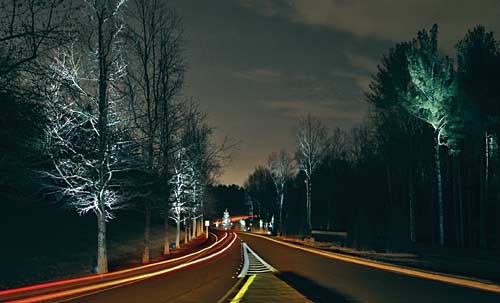The Fourth Source: Light-Emitting Diodes (LEDs) for General Illumination
IESNA, as well as other groups, including the U.S. General Services Administration, recommend that designers and their clients evaluate LED fixtures based on "lighting quality," including minimum measures for such factors as lumen maintenance, correlated color temperature (CCT), color-rendering index (CRI) and glare control. Following are key measures of LED lighting products and systems:
Glare control. There is no standard measure of fixture glare, although manufacturers list photometric data in their catalogs and specification sheets that can help lighting designers and architects reduce the potential for glare in their designs. In order to achieve good levels of interior illuminance produced energy-efficiently with LEDs, designers must look for high lumen output and high efficacy, both of which tend to increase glare.
Installed wattage. The LED lighting system's installed power describes the total power required to operate the luminaires, including the draw for ballasts, current regulators and control devices, in addition to the LED lamps. This total measure of required power more accurately describes energy use than lumens per watt. For this reason, many energy codes and efficiency ratings define "high-efficacy luminaires" and efficiency based on total line voltage rather than lamp wattage.
Lumen maintenance. The rate of decline in light output over time of a light source is called lumen maintenance, a variable usually expressed as a percent of initial light output after the device is operated for a given number of hours. Fixture and lamp manufacturers will describe the lumen maintenance of their products numerically and with curves. Specifiers should be aware that LED and other light sources will fluctuate in output with changes in ambient (air) temperature and device temperature. But while fluorescent lamps are known for dimming as they get colder, LEDs actually brighten at varying rates depending on the type of LED in cold weather. Specifiers should evaluate and document these typical variations based on data provided by the fixture manufacturer.
Correlated color temperature. By comparing the color appearance of the illumination emitted from a subject source to that of a reference source is known as the correlated color temperature, or CCT, measured in degrees Kelvin (K). For general illumination, typical CCT values include 2700K and 3000K ("warm" sources), and 3500K, 4100K and 5000K ("cool" sources). LEDs tend to have CCTs that vary over the life of the sources, so specifiers must be aware not only of the CCT but also its expected change over time.
Color rendering. The color rendering index, or CRI, describes a light source's ability to produce visually accurate colors of illuminated targets based on comparison with a standard or reference light source with the same color temperature. CRI is given as a number between 1 and 100; for general illumination applications, high CRIs are important, as they improve visual clarity and contrast. Good CRI also correlates with building occupants' productivity levels and their opinions on whether their indoor environments are appealing.
Other factors that influence the choice of an LED fixture for general lighting applications include: the durability of the fixture; luminaire design; and the suitability of the fixture to the application environment.
Standards on the way
While standards regarding how manufacturers report on the useful life and lumen maintenance of LED fixtures may not be available currently, lighting organizations are in the process of developing ratings, tests and other criteria to describe LED performance. This year, Underwriters Laboratories (UL) is publishing UL 8750, Outline of Investigation for LED Light Sources for Use in Lighting Products, to report on LED sources used in fixtures and products bearing the UL listing, including the heat produced by the sources. Procedures for manufacturers' photometric measurements of LEDs are being drafted by IESNA and the Next Generation Lighting Industry Alliance with the DOE's Building Technologies Program.
The new safety and performance data, standardized and consolidated for easy use by lighting specifiers, will improve the acceptance of LEDs for general illumination by architects and their clients. According to the DOE report Next Generation Lighting Initiative: Commercial Application Activities, "by 2025, SSL could displace general-illumination light sources such as incandescent and fluorescent lamps, decreasing national energy consumption for lighting by about 0.45 quadrillion Btu (quads) annually, that is, enough energy saved to serve the lighting demand of 20 million households today."
The use of LEDs in general illumination has been well established for several years now, however, and the rate of adoption has outpaced most industry expectations. This has led many manufacturers to build more capacity for producing general-illumination LED luminaires.
The benefits of LED lighting for general-purpose applications are numerous: reduced light losses, high efficiencies and compatibility with existing dimmers, among others. New techniques in product and system design are more effectively mitigating the heat produced by LED clusters, boosting useful life and consistency of illumination. Last, manufacturers are providing higher lumen outputs--and more consistent outputs over time--from diodes that emit white light.
These facts suggest that architects, lighting designers, engineers and other building design professionals will need to learn more about the use of LEDs in general illumination. By ensuring that only high-quality, specification-grade fixtures are used in their projects, they will help ensure the rapid market acceptance of a promising new technology for reducing energy use and lighting system obsolescence.
Â
Â
|
Â
Â
Â
|
Â
Â









